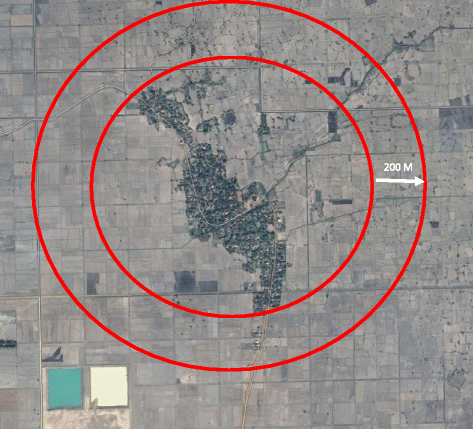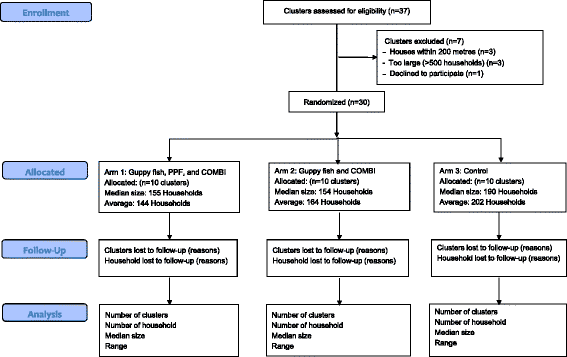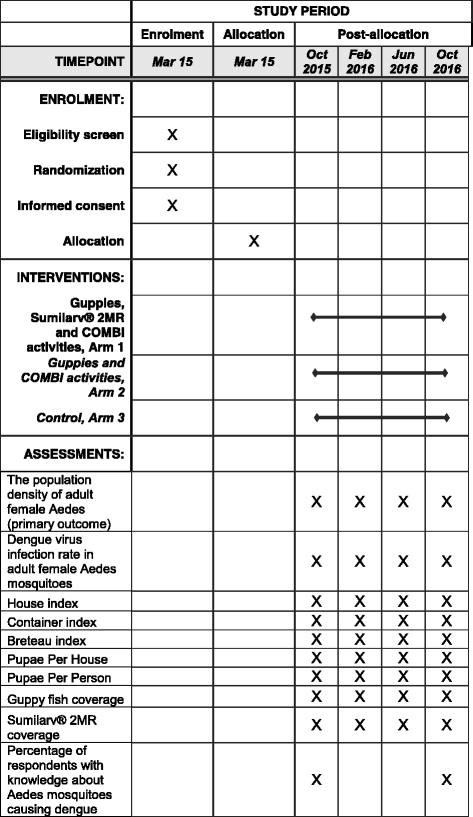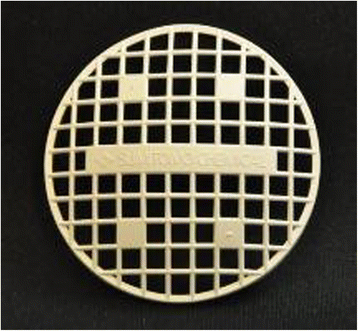Determining the efficacy of guppies and pyriproxyfen (Sumilarv® 2MR) combined with community engagement on dengue vectors in Cambodia: study protocol for a randomized controlled trial
- PMID: 28778174
- PMCID: PMC5545006
- DOI: 10.1186/s13063-017-2105-2
Determining the efficacy of guppies and pyriproxyfen (Sumilarv® 2MR) combined with community engagement on dengue vectors in Cambodia: study protocol for a randomized controlled trial
Abstract
Background: Evidence on the effectiveness of low-cost, sustainable, biological vector-control tools for the Aedes mosquitoes is limited. Therefore, the purpose of this trial is to estimate the impact of guppy fish (guppies), in combination with the use of the larvicide pyriproxyfen (Sumilarv® 2MR), and Communication for Behavioral Impact (COMBI) activities to reduce entomological indices in Cambodia.
Methods/design: In this cluster randomized controlled, superiority trial, 30 clusters comprising one or more villages each (with approximately 170 households) will be allocated, in a 1:1:1 ratio, to receive either (1) three interventions (guppies, Sumilarv® 2MR, and COMBI activities), (2) two interventions (guppies and COMBI activities), or (3) control (standard vector control). Households will be invited to participate, and entomology surveys among 40 randomly selected households per cluster will be carried out quarterly. The primary outcome will be the population density of adult female Aedes mosquitoes (i.e., number per house) trapped using adult resting collections. Secondary outcome measures will include the House Index, Container Index, Breteau Index, Pupae Per House, Pupae Per Person, mosquito infection rate, guppy fish coverage, Sumilarv® 2MR coverage, and percentage of respondents with knowledge about Aedes mosquitoes causing dengue. In the primary analysis, adult female Aedes density and mosquito infection rates will be aggregated over follow-up time points to give a single rate per cluster. This will be analyzed by negative binomial regression, yielding density ratios.
Discussion: This trial is expected to provide robust estimates of the intervention effect. A rigorous evaluation of these vector-control interventions is vital to developing an evidence-based dengue control strategy and to help direct government resources.
Trial registration: Current Controlled Trials, ID: ISRCTN85307778 . Registered on 25 October 2015.
Keywords: Cambodia; Community engagement; Dengue; Guppy; Pyriproxyfen; Vector control.
Conflict of interest statement
Ethical approval and consent to participate
Ethical clearance for this trial has been received by the Cambodian National Ethics Committee for Health Research on 9 October 2014 (ethics reference number 0285). Additionally, ethics approval was received from the London School of Hygiene and Tropical Medicine Observational/Interventions Research Ethics Committee (ethics reference number 8812). The ethical review bodies will review the protocol annually with progress reports from the project teams. Any subsequent modifications to the protocol which may significantly impact or change the study including eligibility criteria, outcomes, or analysis will be communicated to partners and ethical bodies, and will be documented in further publications.
CHWs will explain the trial and receive informed consent from the head of the household before providing the interventions (see Additional file 2). The CHWs will receive prior training on how to seek informed consent. Those who are illiterate or otherwise cannot sign their name will be allowed to give their thumb print. All households will have the ability to remove themselves from the study at any point.
Entomology specimens will be stored at NAMRU-2. Data which contain identifying information, such as names, will be de-identified by assigning individual ID numbers. All village and respondent names will be deleted to ensure that no identifying information is included. Data from surveys will be entered and stored into a password-protected computer. All qualitative data will be collected in concordance with the guidelines of the Code of Ethics of the American Anthropological Association (AAA) [63].
Consent for publication
All authors have consented to publication of this article.
Competing interests
The authors declare that they have no competing interests.
Publisher’s Note
Springer Nature remains neutral with regard to jurisdictional claims in published maps and institutional affiliations.
Figures




Similar articles
-
Field Efficacy of Larvivorous Fish and Pyriproxyfen Combined with Community Engagement on Dengue Vectors in Cambodia: A Randomized Controlled Trial.Am J Trop Med Hyg. 2021 Sep 7;105(5):1265-1276. doi: 10.4269/ajtmh.20-1088. Am J Trop Med Hyg. 2021. PMID: 34491225 Free PMC article. Clinical Trial.
-
Implementation of guppy fish (Poecilia reticulata), and a novel larvicide (Pyriproxyfen) product (Sumilarv 2MR) for dengue control in Cambodia: A qualitative study of acceptability, sustainability and community engagement.PLoS Negl Trop Dis. 2019 Nov 18;13(11):e0007907. doi: 10.1371/journal.pntd.0007907. eCollection 2019 Nov. PLoS Negl Trop Dis. 2019. PMID: 31738759 Free PMC article.
-
Evidence based community mobilization for dengue prevention in Nicaragua and Mexico (Camino Verde, the Green Way): cluster randomized controlled trial.BMJ. 2015 Jul 8;351:h3267. doi: 10.1136/bmj.h3267. BMJ. 2015. PMID: 26156323 Free PMC article. Clinical Trial.
-
Community effectiveness of pyriproxyfen as a dengue vector control method: A systematic review.PLoS Negl Trop Dis. 2017 Jul 17;11(7):e0005651. doi: 10.1371/journal.pntd.0005651. eCollection 2017 Jul. PLoS Negl Trop Dis. 2017. PMID: 28715426 Free PMC article. Review.
-
Assessing the effects of interventions for Aedes aegypti control: systematic review and meta-analysis of cluster randomised controlled trials.BMC Public Health. 2017 May 30;17(Suppl 1):384. doi: 10.1186/s12889-017-4290-z. BMC Public Health. 2017. PMID: 28699552 Free PMC article. Review.
Cited by
-
Review of dengue vectors in Cambodia: distribution, bionomics, vector competence, control and insecticide resistance.Parasit Vectors. 2024 Oct 9;17(1):424. doi: 10.1186/s13071-024-06481-5. Parasit Vectors. 2024. PMID: 39385238 Free PMC article. Review.
-
Entomological outcomes of cluster-randomised, community-driven dengue vector-suppression interventions in Kampong Cham province, Cambodia.PLoS Negl Trop Dis. 2022 Jan 25;16(1):e0010028. doi: 10.1371/journal.pntd.0010028. eCollection 2022 Jan. PLoS Negl Trop Dis. 2022. PMID: 35077452 Free PMC article.
-
Pyriproxyfen, a juvenile hormone analog, damages midgut cells and interferes with behaviors of Aedes aegypti larvae.PeerJ. 2019 Sep 4;7:e7489. doi: 10.7717/peerj.7489. eCollection 2019. PeerJ. 2019. PMID: 31534837 Free PMC article.
-
Fostering social innovation and building adaptive capacity for dengue control in Cambodia: a case study.Infect Dis Poverty. 2020 Sep 3;9(1):126. doi: 10.1186/s40249-020-00734-y. Infect Dis Poverty. 2020. PMID: 32883345 Free PMC article.
-
Current vector research challenges in the greater Mekong subregion for dengue, Malaria, and Other Vector-Borne Diseases: A report from a multisectoral workshop March 2019.PLoS Negl Trop Dis. 2020 Jul 30;14(7):e0008302. doi: 10.1371/journal.pntd.0008302. eCollection 2020 Jul. PLoS Negl Trop Dis. 2020. PMID: 32730249 Free PMC article. No abstract available.
References
-
- World Health Organization . Dengue: guidelines for diagnosis, treatment, prevention, and control. Geneva: World Health Organization; 2009. - PubMed
-
- Dengue. http://www.cdc.gov/dengue. Accessed 13 Oct 2015.
-
- World Health Organization . Update on the dengue situation in the Western Pacific Region. Manila: World Health Organization; 2015.
Publication types
MeSH terms
Substances
Associated data
Grants and funding
LinkOut - more resources
Full Text Sources
Other Literature Sources
Medical

